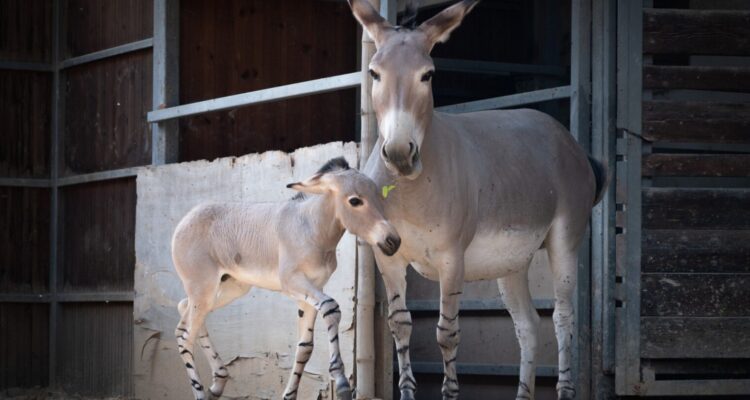A newborn African donkey is one of around only 800 of his species left in the world and is part of an Israeli and European breeding program that seeks to preserve them.
By Abigail Klein Leichman, ISRAEL21c
Broko, a newborn resident of Ramat Gan Safari zoological park, may look like just another donkey.
But he’s causing much excitement among zoo staff because he’s actually a rare animal, a member of the nearly extinct African wild horse family Equidae, the ancestor of the domestic donkey.
Called arode in Hebrew, the African wild donkey is distinguished by its grayish brown color, big ears, long black eyelashes, white belly and white “socks” with black stripes. It’s the smallest wild horse species, according to the zoo.
Broko – his name means “God bless” in the Ethiopian language Amharic – was born in February to Bar and Jude, weighing 15 kilograms (33 pounds). His older sister, Beatrice, was moved to the Berlin Zoo last September.
Jude, nine years old, was born at the Safari. Bar, 10, was born in Hay-Bar Yotvata Nature Reserve in southern Israel and came to Ramat Gan in 2014.
“Israel has a very important role in preserving this special species,” said safari zoologist Keren Or.
“The origin of the entire population in zoos around the world comes from five individuals — three males and two females — that were captured in the Nugaal Valley in Somalia and sent to the zoo in Basel, Switzerland, in July 1970, and 12 that were captured in the Sardo region of the Danakil Desert in Ethiopia in September 1972 and were sent to the Yotvata Nature Reserve here in Israel.”
American and European breeding programs were created from the progeny of these animals, and today there are about 300 African wild donkeys in zoos across the world.
In the European breeding program in which the Safari participates, there are about 170 of these animals in 38 zoos. When he’s around two years old, Broko will be moved to another zoo, according to the recommendation of the coordinator of the European breeding program.
Fewer than 500 African wild donkeys are believed to be living in their natural habitat in the Horn of Africa.
“The threats to the arode population [in the wild] are competition with humans and their herds of sheep for sources of food and water; hunting; as well as the presence of donkeys in their habitat, due to [regular] male donkeys breeding with the females,” Or said.
If you go to the Ramat Gan Safari, Or asks that you stop and admire Broko and his parents. “Unfortunately, many people tend to ignore them. They to themselves, ‘Oh, there’s a donkey’ and move on. Thus they miss one of the most beautiful wild horses.”





